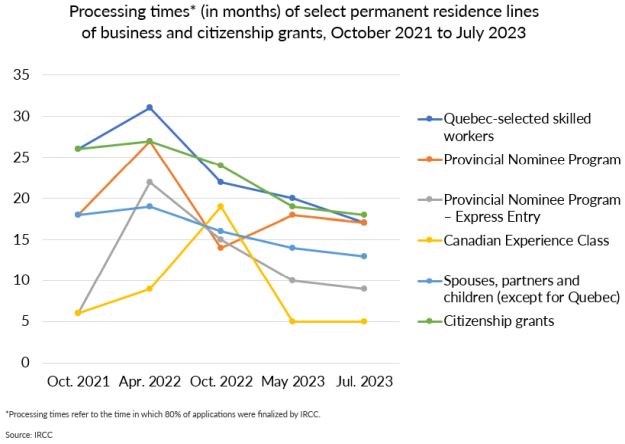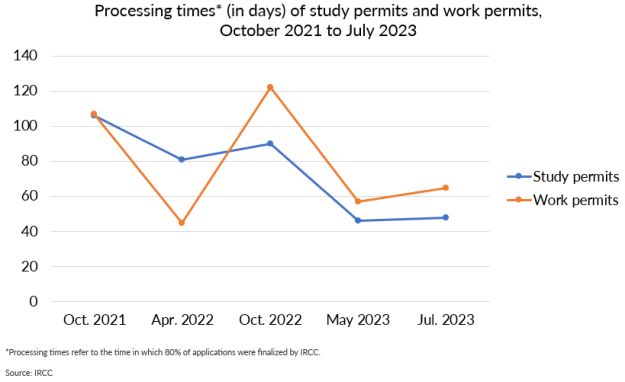1. Permanent Residence – Express Entry
Canada's Express Entry system has undergone some significant adjustments in 2023. Most notably, in May, Immigration, Refugees, and Citizenship Canada ("IRCC") introduced six new categories for category-based selection draws. Category-based selection allows Canada to issue Invitations to Apply (ITAs) to prospective permanent residents with specific skills, training, or language ability. Canada has been targeting prospective permanent residents with the following attributes:
- French language proficiency;
- Healthcare occupations;
- Science, Technology, Engineering and Math (STEM) occupations;
- Trade occupations;
- Transport occupations; and
- Agriculture and agri-food occupations.
All six of these categories have had at least one draw in 2023. In addition to the categories above, Canada's Express Entry program continues to manage applications for the Federal Skilled Worker Program, Federal Skilled Trades Program, and Canadian Experience Class. More details on the Express Entry system can be found here.
2. Addressing Labour Shortages
IRCC has made several important announcements in 2023 to address domestic labour shortages in Canada.
On May 8, 2023, IRCC announced the extension of its Agri-Food Pilot until May 14, 2025. The Government launched this pilot in May 2020 to help temporary foreign workers in the agricultural sector transition to permanent residence. The Agri-Food Pilot aims to address labour shortages in Canadian agriculture by allowing temporary foreign workers (TFW) in agricultural industries to apply for permanent residence if they meet certain requirements. More details on the program can be found here.
Additionally, on June 27, 2023, IRCC announced Canada's first-ever "Tech Talent Strategy", including a new program to provide open work permits for 10,000 H-1B visa holders. This program was intended to bolster the strength of the North American tech sector, by targeting digital nomads to Canada. Within 48 hours of the program opening, the 10,000 limit for the program was reached. It remains to be seen if Canada intends to re-open the program in the future.
Finally, to simplify the hiring process for repeat TFW Program employers, Canada announced in September 2023 the new Recognized Employer Pilot (REP) program. The REP program offers a streamlined approach for employers who regularly access the TFW Program to fill in-demand positions in specified occupations. The program allows eligible employers to obtain extended Labor Market Impact Assessments (LMIAs), valid for up to 36 months. In addition to benefiting from an extended LMIA validity period, there is also a simplified LMIA application process. The REP program is explained here in greater detail.
3. Stabilizing Immigration Levels
After increasing its immigration targets several times in recent years, Canada announced in early November that it is plateauing its immigration target at 500,000 for both 2025 and 2026. In 2024, Canada aims to welcome 485,000 new immigrants.
The Immigration Levels Plan acts as the guideline for the number of new permanent residence applications over the next three years under each of the three immigration classes: economic, family, and humanitarian. In 2024, 58 percent of the annual target will fall under the economic class, 24 percent under the family class, and 19 percent under the humanitarian class.
Addressing why IRCC is keeping its immigration targets unchanged for both 2025 and 2026, the Immigration Minister explained that, "this plan is tailored to support economic growth while balancing with the pressures in areas like housing, healthcare and infrastructure".
4. Prioritizing Francophone Immigration
Although Canada intends to stabilize the number of permanent residence applications in 2025 and 2026, one sub-category of immigrants will see a notable increase in numbers between 2025 and 2026: French-speaking permanent residents outside of Quebec.
According to Canada's latest Immigration Levels Plan, Canada is looking to welcome 31,500 French-speaking permanent residents in 2025 and 36,000 immigrants under the same category in 2026. The Plan also includes new annual and progressively increasing French-speaking permanent resident targets outside Quebec: 6 percent in 2024, 7 percent in 2025 and 8 percent in 2026.
This trend reflects a growing commitment to attracting Francophone immigrants to Canada. According to IRCC's recently releasedStrategic Report,IRCC is developing an ambitious new Francophone Immigration Policy to enhance the vitality of Francophone minority communities in Canada and work toward restoring and increasing their demographic weight.
Other efforts to increase Francophone immigration includes the expansion of the Francophone Mobility Program in June, which was created to allow a Canadian employer to make a job offer to an eligible candidate with a moderate command of French for all National Occupation Classification (NOC) jobs apart from those in primary agriculture, as well as the French language proficiency category-based draw in the Express Entry system.
5. Crisis Response
IRCC has introduced a number of emergency immigration measures to support individuals and communities affected by the crisis.
On February 23, 2023, IRCC announced special measures to support Iranian temporary residents during the civil unrest in their home country. Effective March 1, 2023, special measures included extensions of temporary resident status and the ability to move between temporary resident classes (i.e., from a visitor to a worker). Additional information about these measures, which are set to expire on February 28, 2024, can be found here.
Similarly, on March 29, 2023, IRCC announced new immigration measures to support Turkish and Syrian nationals who were affected by the earthquakes that devastated the region in February. These measures, extended until January 3, 2024, are explained here in greater detail.
More recently, in the wake of the earthquake that devastated Morocco on September 8, 2023, IRCC announced special immigration measures to support Moroccan nationals in Canada.
6. Improving Efficiency
In recent years, the immigration system has been under strain, with backlogs and processing delays affecting applicants in significant ways. Although these remain ongoing issues, IRCC has made efforts to improve them, including moving to digitized applications, hiring and training new staff (including over 1,200 officers in 2022-2023), and harnessing automation technologies to increase processing capacity and efficiency.
The following data published by IRCC indicates that processing times for certain types of temporary and permanent residence applications have decreased between 2022-2023:


In addition, according to the recently released Strategic Report, IRCC also plans to align application intake with available admissions spaces, to prevent years-long waits that applicants can experience when demand far exceeds available spaces.
IRCC also intends to expedite visitor visas. As of June 6, 2023, 13 more countries have been added to a partial visa exempt countries list. Now, travellers from 67 countries can apply for an electronic travel authorization (eTA) instead of a visa – with most eTA applications approved within minutes.
7. Supreme Court Of CanadaDecisions
With respect to jurisprudence, the Supreme Court of Canada weighed in on immigration and refugee matters with two important decisions in 2023.
In Canadian Council for Refugees v. Canada (Citizenship and Immigration), the Supreme Court of Canada tackled the issue of a bilateral treaty known as the "Safe Third Country Agreement" (STCA) between Canada and the United States. As a rule, under the STCA, refugee claimants must seek protection in whichever of the two countries they first enter after leaving their country of origin. The appellants in this case argued the Regulation designating the U.S. as a safe third country violates the rights guaranteed under section 7 (rights to liberty and security of the person) and section 15 (equality) of the Charter of Rights and Freedoms. Writing for a unanimous Supreme Court, Justice Kasirer opined that the Regulation does not infringe section 7 of the Charter and returned the appellants' section 15 claim to the Federal Court for determination.
Additionally, in Mason v Canada (Citizenship and Immigration), the Supreme Court of Canada reviewed section 34(1)(e) of the< em>Immigration and Refugee Protection Act, which provides that "a permanent resident or a foreign national is inadmissible to Canada on security grounds for engaging in acts of violence that would or might endanger the lives or safety of persons in Canada". In Mason, the Supreme Court held that a person can only be found inadmissible to the country under section 34(1)(e) of the IRPA if they engage in violent conduct linked to the national security or the security of Canada.
The content of this article is intended to provide a general guide to the subject matter. Specialist advice should be sought about your specific circumstances.


